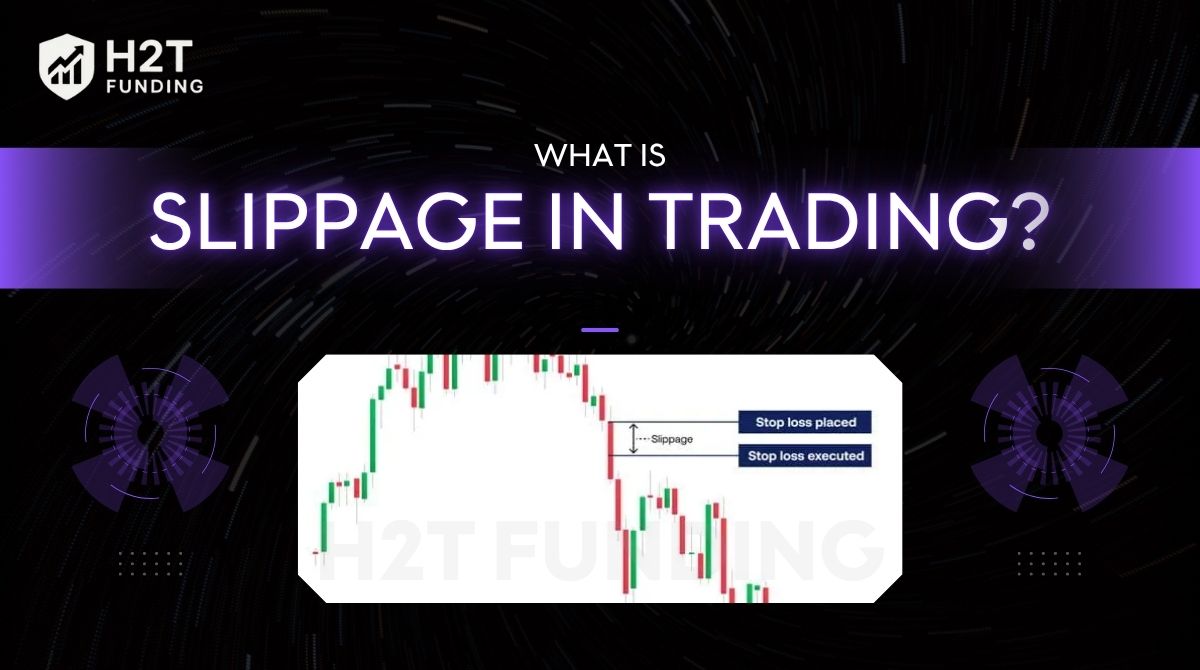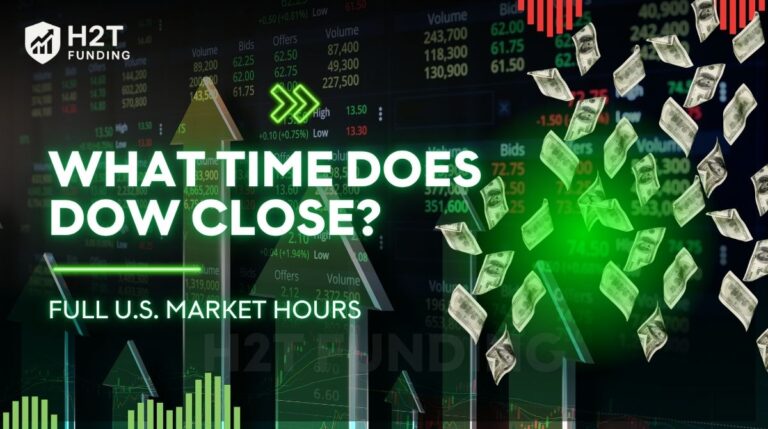If you’ve ever placed a trade and noticed your order didn’t execute exactly at the price you expected, you’ve already encountered slippage. It’s one of those trading terms that every trader hears sooner or later, but few truly understand until they see it happen on their own chart.
So, what is slippage in trading, and how does it work in real situations? To “define slippage in trading,” it’s simply the difference between your intended price and the actual execution price your broker provides. In simple terms, it’s the gap between what you expect and what you actually get when a trade is filled.
This small gap can occur in any market: Forex, stocks, or crypto, often caused by fast market shifts or low liquidity. Even a fraction of a second can make a difference.
H2T Funding will break down everything you need to know about slippage. We will cover how it works in the Forex market, why it happens, how to control it, and how it influences your overall performance. Let’s get started.
Key takeaways:
- Slippage is the gap between your expected price and the actual execution price.
- It is caused by high market volatility, low liquidity, or placing very large orders.
- Slippage can be positive (getting a better price) or negative (getting a worse price).
- You can manage slippage by using limit orders.
- Trading during high-liquidity sessions (like the London-New York hours) also helps reduce risk.
- Some brokers offer premium protection tools to protect against extreme volatility.
- These small gaps can add up and impact your overall profitability.
1. What is slippage in trading?
At its core, the meaning of slippage in trading is the difference between the expected price of a trade and the actual price at which it is executed.
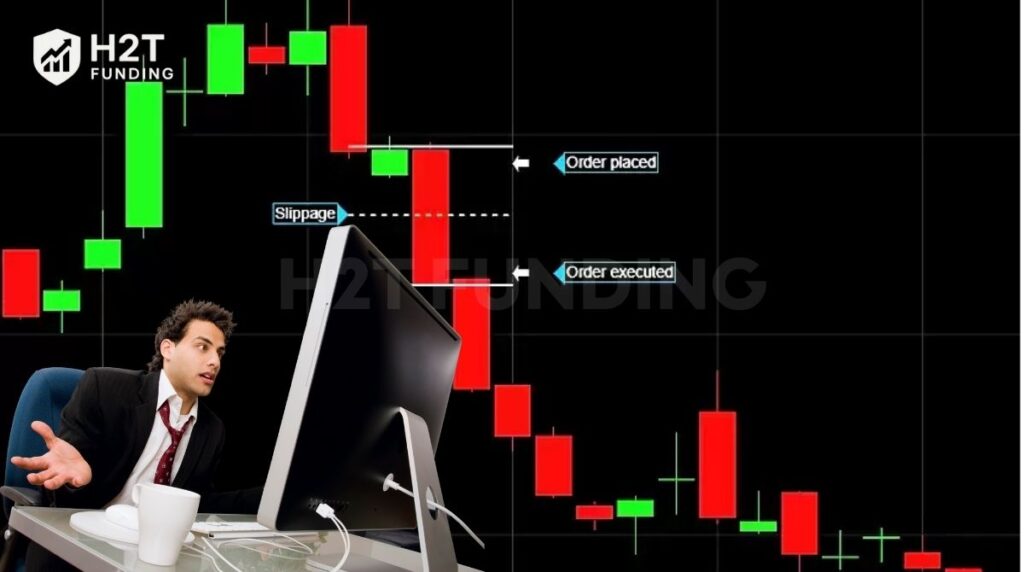
It usually happens when there’s a delay between the time you place an order and the moment it gets filled by your broker. In fast-moving markets, even a split-second delay can cause the price to shift slightly, and that’s slippage.
Think of it like trying to buy something online during a big sale. By the time you click confirm purchase, the price has already changed. The same logic applies to what price slippage is in trading.
Prices are constantly moving because of supply and demand, which is a core part of how currency trading works, so the actual fill rate may not always match your intended entry or exit.
Slippage typically occurs with market orders, especially when market volatility is high or when liquidity is low. For example, during major news events, prices can jump several pips in seconds, making slippage more likely. On the other hand, limit orders can help you control the exact price level at which your trade is executed.
It’s important to remember that slippage isn’t always bad. Sometimes, your trade can be filled at a better price than expected, which is called a positive outcome. Other times, it works against you, resulting in a negative one.
Either way, knowing how it works helps you make more informed trading decisions and manage your risk effectively, which includes understanding advanced tools like the trailing stop-loss versus trailing stop-limit.
2. Slippage in forex vs general trading
Slippage can happen in any market. Forex trading, especially major currency pairs, is highly liquid. However, slippage is still very noticeable when the market is volatile or liquidity drops, which is a key part of what slippage is in trading forex. The Forex market operates 24 hours a day, five days a week, so price changes can occur at any moment, especially when major sessions overlap.
In this specific sector, what is slippage in Forex trading becomes more obvious during high-volatility events, such as central bank interest rate decisions. This is exactly why having what is a trading plan is so crucial.
For traders who know how to understand trading charts, this is very visible: for example, during the U.S. Non-Farm Payroll (NFP) release, the EUR/USD pair has at times moved sharply, such as 20 to 40 pips within a few seconds. If a trader places a buy order at 1.0850, the actual fill might be 1.0858 or even 1.0862, depending on liquidity and execution speed.
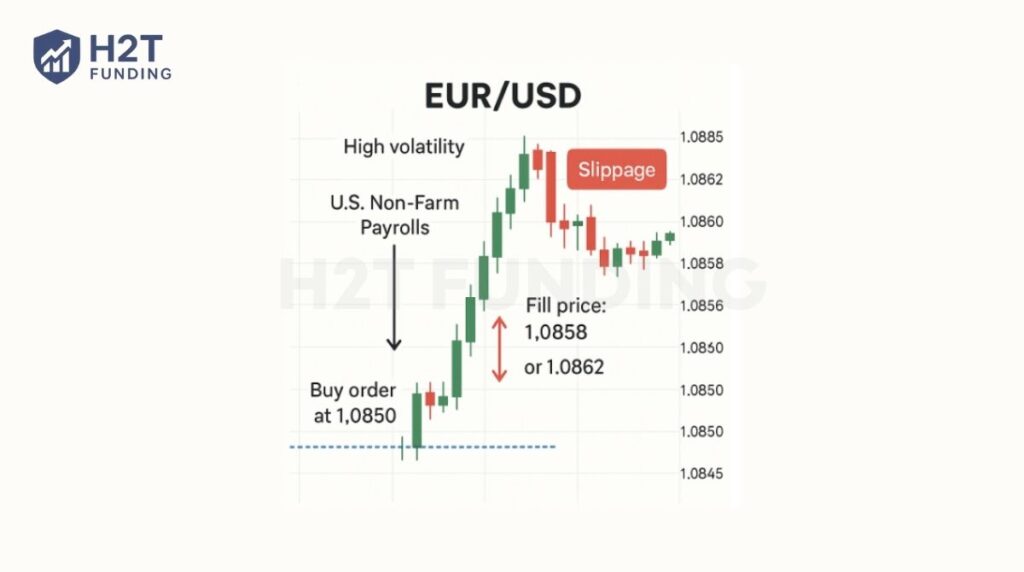
In contrast, markets like stocks or cryptocurrencies experience slippage for different reasons. In stocks, low trading volume or a wide bid/ask spread can cause price slippage, while in crypto, thin liquidity on smaller exchanges often leads to even larger discrepancies.
3. How does slippage occur?
Slippage happens in the tiny time gap between your order and its execution, and it’s almost always caused by two main things: high volatility or low liquidity.
Think of it this way: your trade isn’t truly instant.
There’s always a small delay (we’re talking milliseconds) from the second you click buy to the second your order actually hits the market and gets filled.
That tiny gap is where slippage lives.
- If the market is volatile (like during huge news), prices are jumping around like crazy. In that millisecond delay, the price you wanted can just… vanish. Poof. Your broker has to fill you at the next best price available, which is now different.
- If the market has low liquidity (it’s thin), it just means there aren’t enough people waiting to trade at your exact price. If you want to buy 100 shares at $10.50, but only 20 are for sale, your order eats those 20. It then has to climb to the next price, maybe $10.51, to find the rest.
That’s it. In reality, it’s just the market moving faster than your order can be filled at the price you first saw.
4. Types and examples of slippage
In trading, slippage is generally categorised into three types. All types result from the same factor: a gap between the moment you place an order and the moment it is executed.
Positive Slippage (Favourable)
This occurs when your trade is executed at a better price than you expected. For example, let’s say you place a buy order on EUR/USD at 1.1000, perhaps because you identified what is support and resistance levels are at that round number. In the instant it takes to fill, the price drops slightly, and your order is filled at 1.0998. You received a better entry thanks to 2 pips of price improvement.
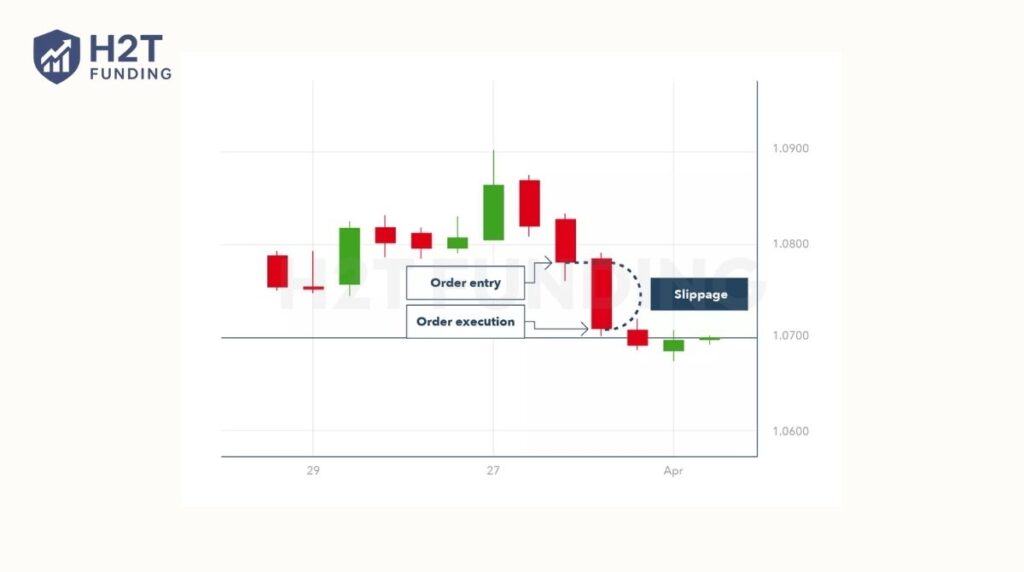
Negative Slippage (Unfavourable)
Negative Slippage (Unfavourable) This is the more common type and happens when your trade is executed at a worse price. To understand what is slippage in trading, this is the classic what is slippage in trading example: Imagine opening a long (buy) position on the AUD/USD currency pair when it was quoted at 0.7026.
However, during the short moment before your order is filled, the price increases to 0.7028. You end up buying higher than planned; that 2-pip difference is your loss.
Zero Slippage
This simply means your order was filled at the exact price you intended, with no deviation. While this is what traders hope for, it can be rare during very fast-moving, volatile market conditions.
You can see this clearly in the chart example above, where the order entry point (perhaps set at the break of what is a trendline in trading) and the order execution point are not aligned.
The small gap between them represents the slippage amount. It might seem minor, but over many trades, these tiny price differences can add up and affect your overall performance.
5. Why does slippage happen?
Slippage happens when there’s a gap between the moment you place an order and the time it’s actually executed. This delay can occur for several reasons related to market conditions, liquidity, and volatility.
5.1. Market volatility
Rapid market shifts often lead to slippage, especially during major economic announcements like interest rate decisions or employment data releases. When volatility spikes, the market can move several pips in a second, causing your execution price to differ from the one you expected.
5.2. Liquidity and trading volume
Low liquidity means there aren’t enough traders willing to buy or sell at your chosen price. This is common in less popular currency pairs or during quiet trading hours, such as the Asian session. In such cases, brokers fill your order at the next available price, which may be slightly worse.
5.3. Order type and execution speed
Instant buy or sell requests are typically the most prone to slippage. This is because their very design prioritises speed over price. When you use a market order, you are telling your broker to execute the trade immediately at the best available price.
If the market is moving quickly, that ‘best available price’ might be different from the one you saw when you clicked, which is the very definition of slippage. In contrast, pending orders help control your entry but might not get filled if the market moves away. The speed of processing also depends on your broker’s technology and the quality of its price feeds.
5.4. Bid/ask spread and market conditions
A wide spread increases the chance of slippage. When spreads widen due to thin liquidity or uncertain market trends, your trade might be executed further from your target level. This is why professional traders monitor spreads closely before entering positions.
5.5. Order size and market impact
Placing an unusually large order can also cause slippage. This happens when your order consumes all available liquidity at the best price. The rest of the order is then forced to fill at the next available and progressively worse price levels. This is common when traders open positions that are too large for the market depth at that moment.
In short, slippage is part of normal trading behaviour in the Forex market and other financial instruments. The goal isn’t to eliminate it completely but to understand when it’s likely to happen so you can adjust your approach and manage your risk effectively.
6. How to avoid slippage in trading
While you can’t remove slippage completely, it’s definitely something you can manage. There are several ways to reduce its impact and keep your trading performance consistent. Knowing when and how it happens allows you to make better trading decisions and protect your profits.
Here are the key strategies traders use to control slippage:
- Use limit entries instead of instant execution.
- Trade only during high-liquidity sessions (like London or New York).
- Avoid placing new trades right before major news events (like NFP, CPI, or FOMC).
- Use a high-speed broker, ideally one with an ECN or STP model.
- Check your internet connection speed (ping) or use a VPS.
- Use specialised tools like Guaranteed Stops or set a “slippage tolerance.”
6.1. Choose the right order type
The type of order you use directly affects how slippage plays out. Market orders execute instantly at the current price, but they don’t guarantee precision. Limit orders, on the other hand, let you set a maximum (or minimum) price for entry, helping control your execution price.
However, limit orders carry the risk of not being filled at all if the market price never reaches your specified level, which could mean missing a trading opportunity.
Additionally, some platforms like MT4/MT5 allow you to set a “slippage tolerance” (or “maximum deviation”). This instructs the platform to only fill your order if the price is within a specific range (e.g., 2 pips) of the price you clicked.
6.2. Trade during high-liquidity sessions
Based on many traders’ experience, trading when the Forex market has high liquidity helps reduce the chance of large price jumps.
A common strategy is to focus on overlapping sessions, such as the London–New York hours. This is when trading volume and market participants are typically at their peak. Avoid trading during low-activity periods like late Fridays or holidays, as thin liquidity can lead to significant slippage.
6.3. Avoid major economic announcements
Important financial releases (for example, Non-Farm Payrolls (NFP), CPI inflation reports, or FOMC interest rate decisions) often cause sudden volatility and rapid fluctuations.
This is a common defensive practice. Many traders prefer to wait for the initial market reaction to settle before opening new trading positions, as spreads often widen sharply during those events.
6.4. Monitor spreads and broker execution
A wide bid/ask spread can turn a good entry into a losing trade if prices shift unexpectedly. Keep an eye on spreads and choose brokers that offer fast, transparent order execution. Look for brokers with a reputation for speed, such as those using ECN or STP models, as they are designed to find the best available price quickly.
Some brokers also offer premium protection tools. Unlike regular stops, these ensure your trade closes at the exact price you set, regardless of volatility or gapping, usually in exchange for a small premium or fee. This tool can be vital for managing risk during sharp market fluctuations.
6.5. Check your connection speed
Sometimes, the slippage isn’t the broker’s fault; it’s your own internet connection. Check your “ping” (latency) to your broker’s server. A high ping (e.g., over 100ms) means your order arrives late, giving the market more time to move against you.

If you have slow internet or live far from the broker’s server, consider using a VPS (Virtual Private Server). A VPS is located in a data centre, often in the same building as the broker’s server, ensuring your orders are sent with the lowest possible delay.
6.6. Strengthen your risk management plan
No matter how skilled you are, slippage in trading is unavoidable. The best defence is strong risk management and truly understanding what is consistency rule in trading.
Use appropriate stop-loss orders, calculate position sizes carefully, and don’t risk more than a small percentage of your account on a single trade (a key discipline, much like learning how to stop overspending). Consistency and patience matter more than chasing perfect entries.
By applying these tactics, you’ll understand how to avoid slippage in forex. You will be able to handle slippage in Forex trading and other asset classes with confidence, keeping control even in fast-moving markets.
7. Impact of slippage on your trading performance
When traders ask, What is slippage on trading, they often underestimate how much it can influence real-world results. Slippage affects not only the price you get but also your emotions, consistency, and long-term profitability.
7.1. The hidden cost of slippage
Each time negative slippage happens, your execution price moves slightly away from your intended target. Over hundreds of trades, these small price differences can accumulate into a serious expense.
For example, someone trading the Forex market daily with an average slippage of just 0.5 pips might lose a few dollars per trade, which adds up quickly. This is one of the invisible costs of slippage in trading Forex.
7.2. Positive vs negative outcomes
When defining what is a slippage in trading, it’s important to note that not all slippage is harmful. Positive slippage occurs when your order fills at a better price than expected, improving your return slightly. However, negative slippage, which is more common, can eat into your profits, especially when market volatility is high or liquidity is low.
7.3. How slippage impacts risk and psychology
Unexpected price changes can trigger stops prematurely or cause trades to close at worse levels than planned. This can distort your risk management and lead to frustration if you’re not prepared. Many traders who experience slippage in Forex trading become overly cautious or emotional afterwards, which can harm investor decisions.
7.4. Maintaining consistency despite slippage
Professionals treat slippage as part of the natural flow of market conditions. By tracking average price movement across different currency pairs and adjusting their tactics, they reduce the impact of what is slippage in a trade. The goal is not to eliminate it completely but to manage it intelligently so that overall trading performance remains consistent.
In short, understanding what slippage trading is helps traders make better decisions, stay calm under pressure, and plan their entries and exits more precisely.
8. Slippage vs Spread – What’s the difference?
Simply put, the spread is a cost you always pay, while slippage is a risk that only sometimes happens.
Think of it this way:
The spread is the broker’s fee. It’s that visible, fixed (or variable) gap between the “buy” price (the Ask) and the “sell” price (the Bid). You pay this cost every single time you open a trade, guaranteed. No surprises there.
Slippage, on the other hand, is totally different.
It’s that unpredictable gap between the price you clicked and the price you actually got. It’s not a fee. It’s an event caused by the market moving fast (hello, volatility!) or being too thin (low liquidity).
So, in reality, you pay the spread on every trade, but you only experience slippage when the market is wild. They aren’t the same thing at all!
9. FAQs about slippage in trading
Slippage is the difference between the price you expect when placing an order and the price at which the trade is actually executed. It occurs in all markets but is most noticeable in fast-moving or low-liquidity conditions.
Slippage can be both. Positive slippage happens when you get a better price than expected, while negative slippage means a worse one. Most traders experience both types at some point.
The main causes are market volatility, low liquidity, and execution delays. When the market moves too fast or there aren’t enough buyers or sellers, prices shift before your order is filled.
Yes. The Forex market is active 24 hours a day, which means prices are constantly changing. Slippage is most common during major financial reports or when trading exotic currency pairs.
Yes, that’s considered very high. Normally, slippage in Forex trading is measured in pips rather than percentages. If your trade deviates by 10%, it usually signals extreme volatility or poor execution.
You can use limit orders, trade during high-liquidity sessions, and avoid trading right before big news releases. Choosing a reliable broker with fast order execution also helps.
If slippage becomes excessive, it can distort your trading results and risk calculations. You might enter or exit trades at unfavourable prices, which impacts your profitability.
No. Slippage is an unavoidable part of real-world trading. However, you can control and significantly minimise its impact. You can do this by understanding market behaviour, using order types (like limit orders), and using specialised tools like “guaranteed stops” (which some brokers offer).
Yes. It can occur on both sides, depending on how fast the market moves when your order is executed.
This favourable outcome occurs when your trade fills at a better price than expected, slightly improving your results.
Negative slippage is when you get a worse fill than planned, which can reduce profits or increase losses.
Usually not. Demo accounts use simulated pricing without real liquidity or execution delays, so they don’t fully reflect live trading conditions.
Reputable brokers execute trades at the best available price and disclose their slippage policies clearly. Some even offer guaranteed stops to protect traders from excessive slippage.
It changes the actual entry or exit levels of a trade, which can alter your stop-loss and take-profit positions. Factoring slippage into your strategy helps maintain proper risk control.
10. Conclusion
Understanding what is slippage in trading is one of the key lessons every trader must learn. Fully grasping what slippage trading is is vital before risking real capital.
Slippage happens in all markets, from Forex to stocks. And while it can’t be avoided completely, it can be managed wisely. The more you understand how market conditions, liquidity, and execution speed interact, the better you’ll be at controlling them.
At H2T Funding, we believe that mastering small details like slippage makes a big difference in your overall trading performance. By applying solid risk management techniques and using the right tactics, you can turn unpredictable price movements into opportunities rather than setbacks.
If you’re serious about improving your skills and building consistency, explore more resources in our Prop Firm & Trading Strategies section. It’s where experienced traders share insights that help you stay disciplined, manage risk effectively, and trade with confidence – no matter how volatile the market becomes.

